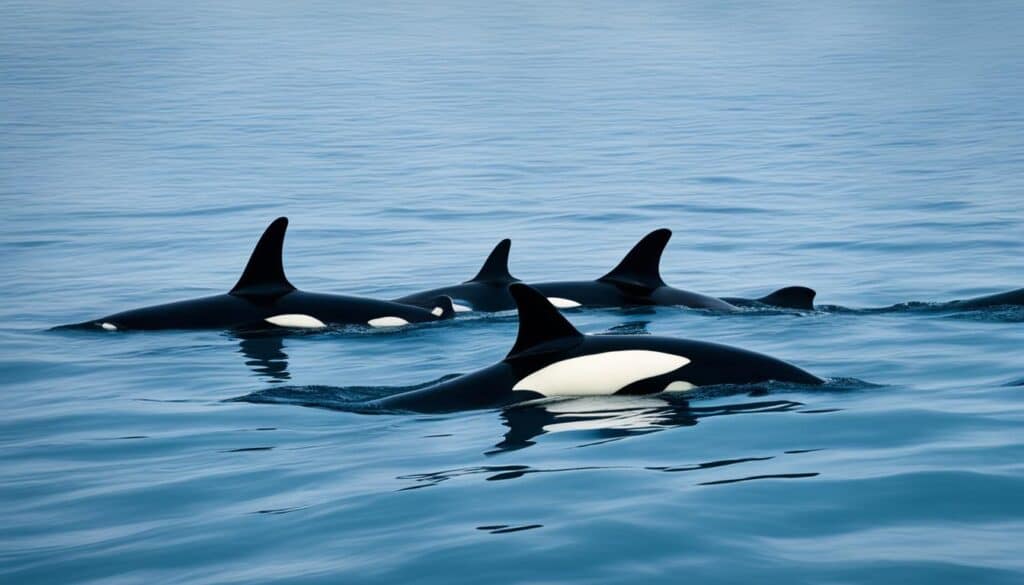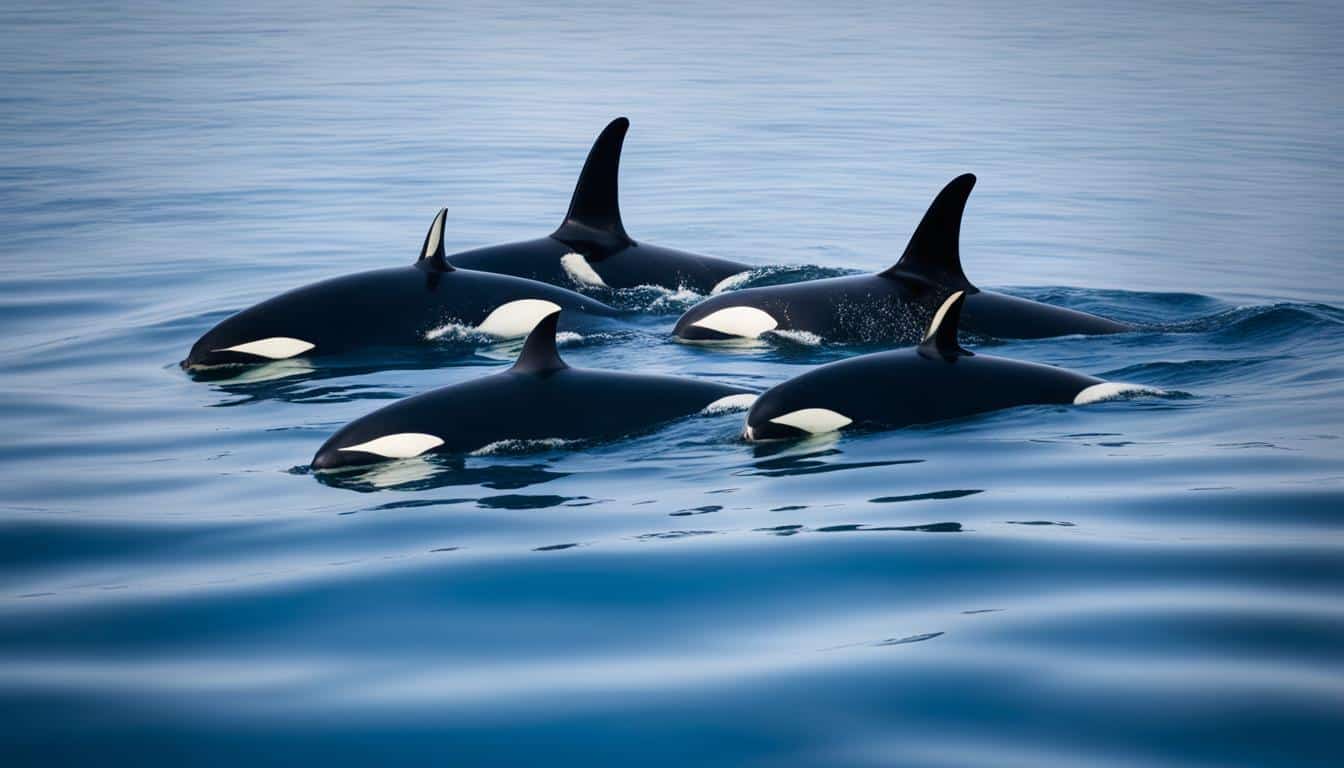Orcas, also known as killer whales, are fascinating creatures that live in the ocean. They can’t sleep like humans do because they need to stay awake to breathe. This means they sleep in a way that keeps them alert, so they don’t drown. Let’s dive into the world of orcas and learn about their sleeping habits and behaviors.
Unlike humans, orcas can’t sleep fully. They need to stay awake to breathe and avoid drowning. This means they sleep in a way that keeps them alert. They sleep with only half their brain at a time, allowing them to rest while still being ready to respond to threats.
Orcas sleep in short periods, usually about 5-20 minutes, and can do this multiple times a day. They can sleep while swimming slowly or floating vertically in the water. This way, they can rest while still being able to quickly respond to any danger.
When orcas sleep, they often float vertically in the water with their blowhole exposed. This allows them to easily breathe and stay alert. They can also sleep while swimming slowly, keeping one eye open to watch for predators.
Orcas have a unique way of sleeping that helps them survive in the ocean. Their ability to sleep while remaining alert is crucial for their survival. By understanding how orcas sleep, we can appreciate their remarkable adaptations and the challenges they face in their underwater world.
Understanding Orca Sleeping Habits
Orcas have fascinating sleep patterns that are different from those on land. They are mammals that need to come up for air while they rest. This affects how they sleep in the water.
Orcas sleep in two main ways. They either swim slowly and rest for short times or stay still near the surface. This stillness lets them breathe safely without swimming a lot.
During these sleep methods, orcas show interesting behaviors. They move little and stay alert, ready to respond quickly to threats. These behaviors show how adaptable and complex their lives are under the sea.
| Method of Sleep | Description | Key Characteristics |
|---|---|---|
| Slow Swimming | Orcas swim slowly while resting. | Maintains awareness, allows for ventilation. |
| Surface Stillness | Resting while floating near the surface. | Safe breathing, minimal energy expenditure. |
How do orcas sleep?
Orcas have unique sleeping habits that show how they’ve adapted to life in the water. These habits help us understand how they sleep while in the ocean. They sleep in a way that lets them keep swimming and breathe, which is key to their survival.
Unihemispheric Sleep Explained
Orcas sleep in a special way called unihemispheric sleep. This means one half of their brain is awake, while the other half sleeps. This lets them keep swimming, breathe, and stay alert for dangers. They can even close one eye while sleeping, keeping watch for threats.
This shows how orcas can rest and stay alert at the same time. It’s a clever way to handle the challenges of living in the ocean.
Voluntary Breathing in Killer Whales
Killer whales control their breathing on purpose. They can’t breathe automatically while they sleep. This is important for them because they need to breathe on their own to stay alive.
Even when they’re sleeping, orcas make sure to come up for air. This keeps them healthy and ready to respond to their underwater world.

| Sleeping Characteristics | Details |
|---|---|
| Type of Sleep | Unihemispheric Sleep |
| Brain Activity | One hemisphere active, one hemisphere resting |
| Eye Behavior | One eye closed, one eye open |
| Breathing Method | Voluntary breathing control |
| Survival Adaptation | Awareness of surroundings and ability to surface for air |
Orca Rest Patterns in the Wild
Orcas rest in ways that show how they live together and sleep. They have special ways of sleeping that keep them safe and close to each other. This helps them stay safe from dangers.
Orcas often rest in groups, swimming together. This keeps them close and helps them feel safe. They might also rest in a way called “logging,” where they float on the water’s surface, looking calm.
Or sometimes, orcas swim slowly while they rest a bit. This way, they can keep an eye on their surroundings and still rest. These complex rest patterns are important for their health. They help them relax and stay alert at the same time.
| Rest Format | Description | Social Benefits |
|---|---|---|
| Logging | Orcas lie horizontally on the water’s surface | Strengthens social bonds as they remain in close proximity |
| Slow Swimming | Orcas swim at a relaxed pace while partially resting | Maintains alertness, enhancing safety within the pod |
Orcas have special ways of resting that show how smart and adaptable they are. These rest patterns help them deal with their environment. They support both their own health and the health of their group.
Orca Behavior During Sleep
Orcas have unique ways of sleeping that show how they’ve adapted over time. When they rest, they swim slowly at the surface. This lets them breathe while still sleeping.
Swim Patterns During Rest
Orcas sleep by swimming in patterns that keep them from sinking. They move along the surface for air. This way, one part of their brain sleeps, and the other stays alert for danger.
Social Sleeping: Pods and Resting Lines
Sleeping together is important for orcas. They rest in groups called pods. This helps them stay safe and keeps them company. It shows how smart and social they are.
Killer Whale Sleeping Positions
The way killer whales sleep is quite interesting and tells us a lot about their orca resting behaviors. They often float on their sides or backs while sleeping. This lets them relax a bit but stay alert for dangers. Sometimes, they even sleep standing up, which helps them stay ready for threats.
Killer whale sleeping positions change for many reasons, like the environment and their social life. Some orcas sleep near the surface, while others go deeper. This flexibility is key for their survival. It lets them rest while still being part of their group.
Sleeping patterns in orcas are also shaped by their social life. The strength of their pod affects how they rest together. Watching them in the wild or on documentaries shows how smart and social they are in their sleep habits.
FAQ
How do orcas sleep without drowning?
Orcas sleep in a special way called unihemispheric sleep. This means one half of their brain rests while the other stays awake. This helps them breathe and stay alert to their surroundings.
What are the sleeping habits of orcas?
Orcas sleep in a complex way. They swim slowly and float near the surface. They also stay close to each other in groups for safety.
Do killer whales sleep in the same way as humans?
No, killer whales don’t sleep like humans. They don’t have deep, unconscious sleep. Instead, they stay alert and control their breathing while resting.
What are some common sleeping positions for orcas?
Orcas can float on their sides or backs, or stand upright in the water. These positions change based on their social life and the environment.
How do orcas manage to breathe while they sleep?
Orcas breathe on purpose. They choose when to inhale and exhale. This lets them control their breathing while they rest.
What social behaviors do orcas display while sleeping?
Orcas sleep in groups, forming resting lines. This helps keep them safe. They can watch out for each other while resting.
How do orca sleeping patterns vary in the wild?
In the wild, orcas rest in different ways. They swim slowly or lie still at the surface. This lets them rest and keep an eye out for dangers.
What unique adaptations do orcas have for resting?
Orcas have a special sleep called unihemispheric sleep. One side of their brain rests while the other stays awake. They also float or swim slowly to breathe and stay alert.







